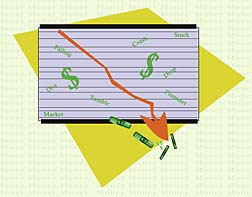From $170 to two bucks in a year. And that's not the half of it. As it was, the $2 stock price when the deal closed was a tenth of what it was worth two days before.
 That's how fast a bear can turn into a bomb in the financial world—and optimism into despair. Anyone with any memory of the Great Depression would recognize the signs. While the Bush administration has signaled with the brokering of this deal that it is not about to allow such a catastrophic event to befall the US economy, the mere fact that an 85-year-old dynasty which itself weathered countless storms and survived the Great Depression could not live through the sub-prime mortgage meltdown is telling.
That's how fast a bear can turn into a bomb in the financial world—and optimism into despair. Anyone with any memory of the Great Depression would recognize the signs. While the Bush administration has signaled with the brokering of this deal that it is not about to allow such a catastrophic event to befall the US economy, the mere fact that an 85-year-old dynasty which itself weathered countless storms and survived the Great Depression could not live through the sub-prime mortgage meltdown is telling.The signs have been building for months, as bank after bank, and lender after lender have posted troubling losses over the last half of 2007. With two-thirds of American households owning their own homes, representing 69 per cent, one could be forgiven for feelings of bullishness given such a figure. With home ownership, and the financing of which serving as a major player in the nation's economic framework, such a strong representation of stability suddenly reveals itself as a house of cards when one considers the exposure to high-risk borrowers, the numbers of which have been steadily climbing.
So much ownership, but so little equity.
For its part, Bear Stearns operated with a long history of rolling the dice. Much of its wealth had been accumulated by staring down risk and going where few would dare to tread.
However, in the end there was simply too much exposure for the firm to survive. By late last week a term not heard since the Great Depression was being whispered: "a run on the bank." Hedge funds had begun expressing some real concerns about Bear Stearns by late Thursday of last week. Jana Partners, a large hedge fund, issued a communiqué to its investors: "In response to many recent inquiries regarding Bear Stearns, we are writing to inform you that we have no direct exposure to Bear Stearns or its affiliates through a prime brokerage relationship or otherwise." The comments appeared in the New York Times on St. Patrick's Day.
Thus the Fed had to step in, and together with the Treasury Department brokered the deal with JPMorgan, a firm that has been doing some cost-cutting of its own—and while not actively campaigning for new acquisitions, had nonetheless remained open for the possibility of a takeover if the right prospect came along.
That prospect was identified Friday, and the players had to work long and hard through the weekend to get the deal done before markets opened Monday in Asia. As it was, the Dow opened 190 points down, but finished about 20 points up at the end of a nail-biting St. Patrick's Day.
What the future holds is unclear. The bigger issue for JPMorgan, beyond the unbelievable price for which it acquired Bear Stearns, is the assumption of the firm's obligations. The Fed provided financing for the transaction, and will guarantee as much as $30 billion to support Bear Stearn's less-liquid assets.
While the deal includes such assets as Bear Stearn's Madison Avenue HQ, there is still uncertainty—especially for the one-third of Bear Stearns employees who hold ownership in the company. There has been talk of staff reductions, and while the crisis has been averted, all eyes will be on JPMorgan and its partners at the Fed, to see how all this plays out.
At the end of the day, however, investors in the once-storied Bear Stearns just don't know what hit them. Parking their money in such a robust company, one that has weathered so many storms in the past, seemed to be such safe bet—one you didn't even have to think about.
Suddenly, investors had to figure out whether it was better for them in the long run to allow Bear Stearns to file for Chapter 11 bankruptcy, for which they were preparing, or approve the fire sale deal that was ultimately consummated over the weekend.
One can imagine how many retirement strategies this has dashed. While markets rise and fall, even the most daring risk-takers will always have a few places to park some cash in a safety zone. Even in the midst of the sub-prime mortgage meltdown, many felt that cigar-chomping Bear Stearns was untouchable.
From $171, to $2 a share in a year, and a drop of 90 per cent in two days. Just imagine.
READ MORE LEGAL NEWS
James E. Cayne, a former CEO of Bear Stearns and one of its largest shareholders, owns Bear Stearns stock that today is worth $13.4 million. However a year ago that stock would have netted him $1.2 billion.Now comes the worry that if this could happen to Bear Stearns, who's next? While no one is predicting such a dire thing as a collapse in the nation's economy, most agree that the US is heading for recession. For how long, or how deep is anyone's guess.
The fact remains, however, that somewhere in the bowels and boardrooms of Bear Stearns, decisions were made that, in the end, brought the Bear down. Shareholders have the right to question those decisions, and will likely be looking for someone to answer to those losses by any legal channel open to them.




